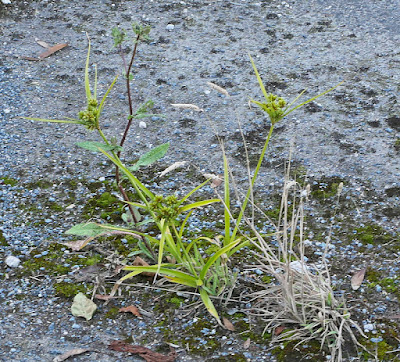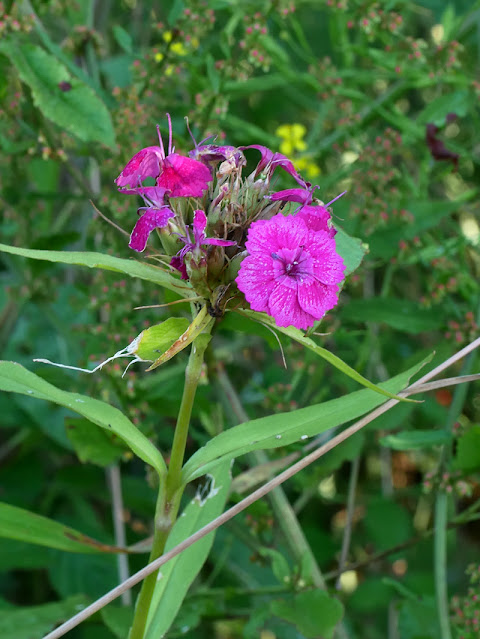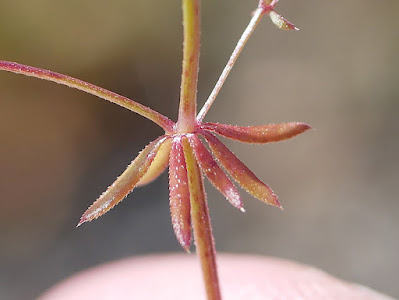I don't know where the time goes. It seems like only a short time ago that the Spring flowers were opening and now we are well into Summer. Having said that, the weather hasn't been very summery at all, with only a few sunny warm days, the rest being overcast or wet. However, that's not all bad news, as the plants like to be kept watered and last longer as a result. Here follows some of my early to mid July finds in Cornwall.
Below is a very misleading photo from a Cornwall Botany Group field trip to Northcott Mouth north of Bude. It's misleading as it rained incessantly for most of the trip and we cut it short, dripping and bedraggled. A strong onshore wind didn't help matters either. Yet, a mile away north or south, it was a sunny dry day! We got stuck under a conveyor belt of heavy showers, unfortunate, but sometimes that's how it is.
Due to the rain, I took very few photos as my camera and lens are not waterproof. I did take some photos of Common Dodder parasitising Common Gorse.
Cuscuta epithymum
I took a local evening walk around Egloshayle near Wadebridge and found some Wild Onion, or Crow Garlic growing on a cemetery wall.
Allium vineale
In a garden centre car park, growing through the tarmac, was an umbrella plant. This seems to pop up fairly often in the wild, mostly near habitation, but I did find some on arable field edges once.
Cyperus eragrostis
Sweet William naturalised near a churchyard which was its probable origin.
Dianthus barbaratus
The host of small Willowherb species aren't very exciting to look at and can be quite complicated to work out at times. The one below is Spear-leaved Willowherb, a speciality for the South West of England. It has a cross shaped stigma and unlike other species it has stalked lanceolate leaves. These often turn deep red as it ages and the flower is paler than the others. I had this verified by the BSBI Epilobium referee too.
Epilobium lanceolatum
Field Scabious is declining nationally and is a Cornwall axiophyte species (indicative of good habitat where it grows). As such, I always record them when I find them. These were on a Cornish hedge, so I could get under them for a different type of photo to the usual.
Knautia arvensis
The most common Mallows I see in Cornwall are Common, Musk and Tree Mallow, however, there are several other species to consider, including a few garden escaped tree mallow species. The flowers below were so vivid and the leaves quite large that I checked them out thoroughly in the books to see if they were something unusual. However, it turned out to be just Common Mallow, but what a lovely example of one.
Malva sylvestris
Lemon Balm was growing naturalised on a roadside bit of waste ground and as I knelt to photograph it, the smell was indeed very lemony!
Melissa officinalis
On the Cornish coastline and on the moors, English Stonecrop is the species you will find in numbers, however, once you get into urban areas or near gardens, White Stonecrop takes over. With its umbels of flowers it's a much showier Sedum than English Stonecrop, but it lacks pink in the flowers, so doesn't look as spectacular when there is a carpet of them.
Sedum album
One of the advantages of attending field trips with a botany group is that you can draw on the expertise of the others present. On this CBG trip to Cadson Bury Hill near Callington, we found Fragrant Agrimony, a plant I had looked for, but had never previously found.
It differs from the usual Agrimony in having almost smooth bases to their seedpods and the undersides of the leaves having numerous fragrant glandular hairs , so if you rub them, your fingers will have a pleasant smell left by those glands. Leaves are supposed to be bigger too, but I couldn't quite see that in this specimen.
Agrimonia procera
Autumn Hawkweed were about to flower at Cadson Bury Hill, several of them were popping up along the top of the hill.
Hieracium sabaudum
Cornwall Botany Group field trip to Cadson Bury Hill, admiring acidic grassland on the way down.
Cow-wheat was present in good numbers too.
Melampyrum pratense subsp pratense
Both species of Gorse were growing right on top of each other allowing for some comparison photos; they really do look quite different. Western Gorse is flowering now.
Gorse Comparison
Ulex gallii in flower
The last photo from that field trip was of Zig Zag Clover with its Red Clover like inflorescenses (but unlike Red Clover the whole being on a stalk above the sub tending leaves) and the narrower, hairy leaves of course.
Trifolium medium
On my way home from Callington, I stopped off to record a the road verges around the A38 near Liskeard. I was drawn to them as I drove by, by the fact that there were several bare areas on the verges and these aften have rare plants growing in them. I wasn't disappointed.
First nice plant wasn't on the bare ground, but nearby. It was Hairy Bindweed, which has a pink striped flower the same size as Large Bindweed, with sepals overlapping too. However, the flower stalk is usually winged and may also be hairy. This specimen was both winged and hairy, so an easy one.
Calystegia pulchra
On the bare aggregate of a slip road I found hundreds of Wall Bedstraw. They had all gone to seed and turned red now, but the growth form is quite unusual, being thin and weedy looking, with whorls of 6-7 leaves. Prickles on the leaves all point forward and the prickles on the stems downwards.
Galium parisience
On the same verge were several clumps of Imperforate St. John's-wort, this was only the second time I'd ever seen this species. As the name suggests, the leaves lack the transluscent spots and the petals are streaked with lines of black glands.
Hypericum maculatum
My star find from this verge were around 50 flowering spikes of Pennyroyal, a very uncommon plant in the Mint family. I suspect they were brought here by birds carrying or pooping out their seeds. There were some recorded on the opposite carriageway a while back but they have spread here since then.
To reliably separate them from Corn Mint, check the sepals. They should be hairy and the lower two being thinner and longer than the upper three.
Mentha pulegium
Here's a habitat shot which goes for the Pennyroyal and Imperforate St. John's-wort and a host of other species too.
That finishes off the first half of July, I hope you enjoyed this selection of plants. So until the end of the month, I will leave you. I hope you too find some lovely wild plants in your area too.
Take Care
Dave




































No comments:
Post a Comment
All comments are moderated before publication, so please don't bother spamming me, thank you. Genuine comments most welcome.